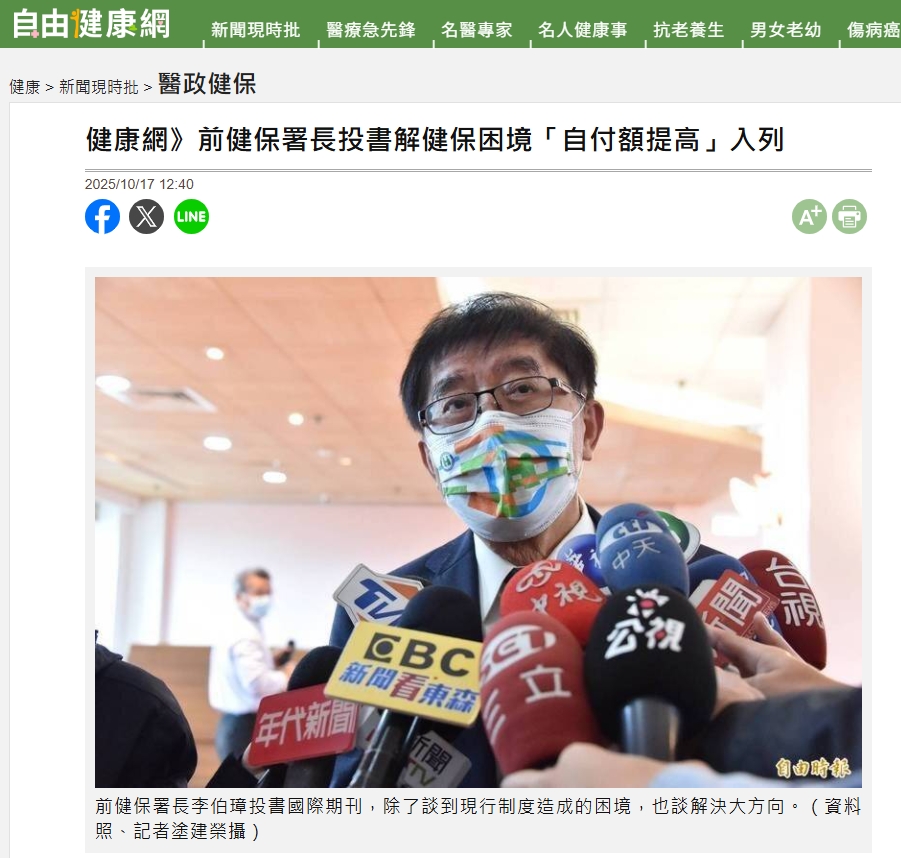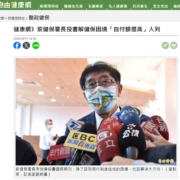【Media Report】The former director of the National Health Insurance Agency of “Free Health Network” submitted a letter to solve the dilemma of health insurance, and the “deductible increase” was listed

2025.10.17 [Health Channel / Comprehensive Report]
Recent discussions surrounding overwork among healthcare professionals and the reform of Taiwan’s National Health Insurance (NHI) system have intensified. Experts from various sectors have shared their experiences and international comparisons in search of feasible improvements. Former Director-General of the National Health Insurance Administration (NHIA) and Chair Professor at Taipei Medical University’s College of Public Health, Lee Po-Chang, together with several co-authors, published an article titled “Systemic strains and reform imperatives in Taiwan’s health-care system” in the international journal The Lancet. The paper provides an in-depth analysis of the current challenges faced by Taiwan’s healthcare sector and proposes several reform measures.
Lee Po-Chang identified the following major issues:
-
Fee-for-Service Payment Model:
The article points out that Taiwan’s fee-for-service model encourages service volume but inadvertently shifts the focus of medical institutions from “quality” to “quantity.” Physicians are often compelled to increase prescriptions and diagnostic tests to maintain income, leading to excessive consumption of medical resources. While this system supports high accessibility and low co-payment, it also creates a vicious cycle of overutilization and physician burnout. -
The Double-Edged Sword of Universal Health Coverage:
Taiwan’s low out-of-pocket payment system allows easy access to healthcare, resulting in high consultation rates and a high physician-to-patient ratio. While this reflects the success of universal health coverage, it also places an enormous burden on the healthcare system. The public’s “medical overuse” further strains physicians, compromising both care quality and patient safety. -
Chronic Shortage of Healthcare Workforce:
The authors highlight the shortage of healthcare personnel with data: Taiwan has only 2.39 physicians per 1,000 people, far below Japan (2.60), South Korea (2.51), and the OECD average (3.66). Nursing manpower is also insufficient—3.33 nurses per 1,000 people (compared with a required 8), while Japan and the OECD average 12.10 and 9.66 respectively.
More than one-third of physicians work over 60 hours per week, and over half of those participating in Pay-for-Performance (P4P) programs do not actually receive bonuses; some even share losses. Long working hours and inequitable pay have triggered burnout and high turnover, further worsening the workforce gap. -
Stagnation in Systemic Reform:
The article stresses that NHI reforms in Taiwan have long focused on “payment adjustments” or “point value recalibration” rather than structural changes. The current challenges extend beyond financial strain—they threaten the sustainability of the system and the resilience of medical professionalism. Without redistributing workloads, realigning incentive structures, and establishing fair cost-sharing mechanisms, the long-term sustainability of NHI may be at risk.
Regarding NHI reform, Lee Po-Chang proposes that efforts should “go beyond tweaking reimbursement formulas” and focus on the following key directions:
● Rebalancing Workload:
Alleviate administrative burdens on clinical physicians through better division of labor and digital support systems; strengthen primary care and community health networks to reduce overconcentration in large hospitals.
● Aligning Incentives with Value-Based Care:
Shift from fee-for-service to value-based care; link performance rewards to care quality, patient satisfaction, and long-term health outcomes. Additionally, introduce non-monetary incentives that enhance job satisfaction and professional growth, such as educational support, career development, and mental health protection.
● Rational Cost-Sharing:
Introduce modest increases in co-payments or implement a tiered cost-sharing system to discourage unnecessary visits. Promote public education on the finite nature of healthcare resources to encourage responsible use of medical services.
Finally, Lee Po-Chang emphasizes that only by embedding sustainability at the core of institutional design can Taiwan’s National Health Insurance system maintain resilience and equity amid future challenges such as population aging, rising medical technology costs, and pandemics.
Original Source:https://health.ltn.com.tw/article/breakingnews/5214267
Full Journal Article:https://www.thelancet.com/journals/lancet/article/PIIS0140-6736(25)01809-4/fulltext


